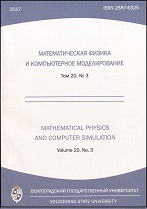|
Mathematics
Optimal recovery of analytic functions’ secondary derivatives by their values at a finite number of points
M. P. Ovchintsev
Moscow State University of Civil Engineering
Abstract:
Many works are devoted to the problems of optimal recovery of a linear functional defined on a certain class of functions from information on the values of functions at a finite number of points (see, for example, [1; 2]). In this article we study the problem of best approximation of the second derivative of a bounded analytic function given in the unit circle at a point with respect to the value of the first derivative at this point, and also the values of the function in some finite collection of points. The article consists of three sections.
The introduction contains the necessary information from the articles of K.Yu. Osipenko. The definition of the best approximation method, the existence of the linear best method, and the formula for calculating the error of the best method are recalled. Also some necessary results from S.Ya. Khavinson articles are given.
In the second section, the error of the best approximation method is calculated. For this a family of functions, which is used to find the error of the best method, is factorized. After this, the required error is calculated directly. It is noted, that the extremal function, used to determine the error of the best method, is unique up to a multiplier eiδ, δ∈R.
In the last section, the coefficients of the linear best method are calculated. To do this, we use the corresponding contour integral, taken along the unit circle. This integral is estimated modulo from above, and then it is calculated. As a result, the coefficients of the linear best method are obtained. At the end of the paper, the uniqueness of the linear best method is established using the relation connecting the extremal functions (see [3]).
Keywords:
optimal recovery, analytic function, the best method, error of the best method, extremal function, linear best method, coefficients of the linear best method.
Citation:
M. P. Ovchintsev, “Optimal recovery of analytic functions’ secondary derivatives by their values at a finite number of points”, Mathematical Physics and Computer Simulation, 20:4 (2017), 76–82
Linking options:
https://www.mathnet.ru/eng/vvgum198 https://www.mathnet.ru/eng/vvgum/v20/i4/p76
|

|




 Contact us:
Contact us: Terms of Use
Terms of Use
 Registration to the website
Registration to the website Logotypes
Logotypes









 Citation in format
Citation in format 